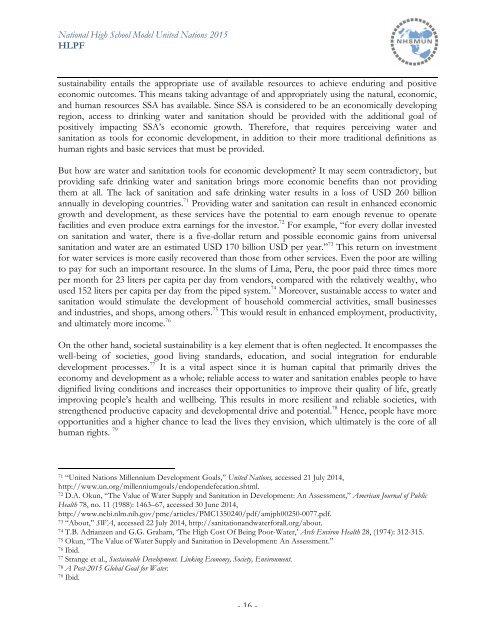d5MrHv
d5MrHv
d5MrHv
You also want an ePaper? Increase the reach of your titles
YUMPU automatically turns print PDFs into web optimized ePapers that Google loves.
National High School Model United Nations 2015<br />
HLPF<br />
sustainability entails the appropriate use of available resources to achieve enduring and positive<br />
economic outcomes. This means taking advantage of and appropriately using the natural, economic,<br />
and human resources SSA has available. Since SSA is considered to be an economically developing<br />
region, access to drinking water and sanitation should be provided with the additional goal of<br />
positively impacting SSA’s economic growth. Therefore, that requires perceiving water and<br />
sanitation as tools for economic development, in addition to their more traditional definitions as<br />
human rights and basic services that must be provided.<br />
But how are water and sanitation tools for economic development? It may seem contradictory, but<br />
providing safe drinking water and sanitation brings more economic benefits than not providing<br />
them at all. The lack of sanitation and safe drinking water results in a loss of USD 260 billion<br />
annually in developing countries. 71 Providing water and sanitation can result in enhanced economic<br />
growth and development, as these services have the potential to earn enough revenue to operate<br />
facilities and even produce extra earnings for the investor. 72 For example, “for every dollar invested<br />
on sanitation and water, there is a five-dollar return and possible economic gains from universal<br />
sanitation and water are an estimated USD 170 billion USD per year.” 73 This return on investment<br />
for water services is more easily recovered than those from other services. Even the poor are willing<br />
to pay for such an important resource. In the slums of Lima, Peru, the poor paid three times more<br />
per month for 23 liters per capita per day from vendors, compared with the relatively wealthy, who<br />
used 152 liters per capita per day from the piped system. 74 Moreover, sustainable access to water and<br />
sanitation would stimulate the development of household commercial activities, small businesses<br />
and industries, and shops, among others. 75 This would result in enhanced employment, productivity,<br />
and ultimately more income. 76<br />
On the other hand, societal sustainability is a key element that is often neglected. It encompasses the<br />
well-being of societies, good living standards, education, and social integration for endurable<br />
development processes. 77 It is a vital aspect since it is human capital that primarily drives the<br />
economy and development as a whole; reliable access to water and sanitation enables people to have<br />
dignified living conditions and increases their opportunities to improve their quality of life, greatly<br />
improving people’s health and wellbeing. This results in more resilient and reliable societies, with<br />
strengthened productive capacity and developmental drive and potential. 78 Hence, people have more<br />
opportunities and a higher chance to lead the lives they envision, which ultimately is the core of all<br />
human rights. 79<br />
!!!!!!!!!!!!!!!!!!!!!!!!!!!!!!!!!!!!!!!!!!!!!!!!!!!!!!!!!!!!<br />
71 “United Nations Millennium Development Goals,” United Nations, accessed 21 July 2014,<br />
http://www.un.org/millenniumgoals/endopendefecation.shtml.<br />
72 D.A. Okun, “The Value of Water Supply and Sanitation in Development: An Assessment,” American Journal of Public<br />
Health 78, no. 11 (1988): 1463–67, accessed 30 June 2014,<br />
http://www.ncbi.nlm.nih.gov/pmc/articles/PMC1350240/pdf/amjph00250-0077.pdf.<br />
73 “About,” SWA, accessed 22 July 2014, http://sanitationandwaterforall.org/about.<br />
74 T.B. Adrianzen and G.G. Graham, ‘The High Cost Of Being Poor-Water,’ Arch Environ Health 28, (1974): 312-315.<br />
75 Okun, “The Value of Water Supply and Sanitation in Development: An Assessment.”<br />
76 Ibid.<br />
77 Strange et al., Sustainable Development. Linking Economy, Society, Environment.<br />
78 A Post-2015 Global Goal for Water.<br />
79 Ibid.<br />
- 16 -


